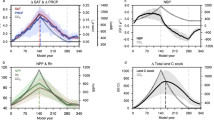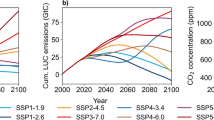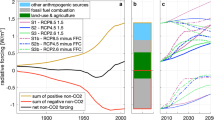Abstract
Future levels of climate change depend not only on carbon emissions but also on carbon uptake by the land and the ocean. Here we are using the Earth system model (ESM1) version of the Australian Community Climate and Earth System Simulator (ACCESS) to explore the potential and impact of removing carbon dioxide (CO2) from the atmosphere through the climate and carbon cycle reversibility experiment. This experiment builds on the standard Coupled Model Intercomparison Project (CMIP) experiment, increasing CO2 at 1% per year until 4xCO2 is reached. The atmospheric CO2 levels are then decreased at the same rate which brings the CO2 back to pre-industrial levels. We then continue to run the model with constant CO2 for another 350 years. Our analysis focuses on the response of the land carbon cycle. We find that carbon stores are largely reversible at the global scale over the timescale of changing CO2. However, carbon stores continue to decrease after CO2 returns to its initial value, and the land loses another 40 Pg of carbon (PgC) with the largest change in the tropics. It takes about 300 years beyond the period of changing CO2 for the carbon stores to recover. Interestingly, we saw strong regional variations in the strength of the land response to changing CO2. Australia showed the largest increase/decrease in biomass carbon (about 40%) and the largest variability in productivity, which was strongly correlated with rainfall. This highlights the importance of assessing the regional response to understanding the processes underlying the response and the sensitivity of these processes within each model. This understanding will benefit future multi-model analyses of this reversibility experiment. It also illustrates more generally the potential to use Earth system model experiments as part of the evaluation of proposed applications of carbon dioxide removal (CDR) technologies. As such, we recommend that these types of modelling experiments be included when mitigation policies are developed.







Similar content being viewed by others
References
Ahlström A, Raupach MR, Schurgers G et al (2015) The dominant role of semi-arid ecosystems in the trend and variability of the land CO2 sink. Science 348:895–899. https://doi.org/10.1126/science.aaa1668
Betts RA, Alfieri L, Bradshaw C et al (2018) Changes in climate extremes, fresh water availability and vulnerability to food insecurity projected at 1.5 °C and 2 °C global warming with a higher-resolution global climate model. Philos Trans A Math Phys Eng Sci 376:2119. https://doi.org/10.1098/rsta.2016.0452
Bi D, Dix M, Marsland SJ, O’Farrell S, Rashid HA, Uotila P, Hirst AC, Kowalczyk E, Golebiewski M, Sullivan A, Yan H, Hannah N, Franklin C, Sun Z, Vohralik P, Watterson I, Zhou X, Fiedler R, Collier M, Ma Y, Noonan J, Stevens L, Uhe P, Zhu H, Griffies SM, Hill R, Harris C, Puri K (2013a) The ACCESS coupled model: description, control climate and evaluation. Aust Meteor Oceanogr J 63:41–64
Bi D, Marsland SJ, Uotila P, O'Farrell S, Fiedler R, Sullivan A, Griffies SM, Zhou X, Hirst AC (2013b) ACCESS-OM: the ocean and sea-ice core of the ACCESS coupled model. Aust Meteor Oceanogr J 63:213–232
Boucher O, Halloran PR, Burke EJ, Doutriaux-Boucher M, Jones CD, Lowe J, Ringer MA, Robertson E, Wu P (2012) Reversibility in an Earth system model in response to CO2 concentration changes. Environ Res Lett 7:24013. https://doi.org/10.1088/1748-9326/7/2/024013
Boysen LR, Lucht W, Gerten D, Heck V, Lenton TM, Schellnhuber HJ (2017) The limits to global-warming mitigation by terrestrial carbon removal. Earths Future 5:463–474
Cao L, Bala G, Caldeira K (2011) Why is there a short-term increase in global precipitation in response to diminished CO2 forcing? Geophys Res Lett 38:6. https://doi.org/10.1029/2011GL046713
Cox PM, Betts RA, Jones CD, Spall SA, Totterdell IJ (2000) Acceleration of global warming due to carbon-cycle feedbacks in a coupled climate model. Nature 408:184–187
Cox P, Betts R, Collins M et al (2004) Amazonian forest dieback under climate-carbon cycle projections for the 21st century. Theor Appl Climatol 78:137. https://doi.org/10.1007/s00704-004-0049-4
Craig A, Valcke S, Coquart L (2017) Development and performance of a new version of the OASIS coupler, OASIS3-MCT_3.0. Geosci Model Dev 10:3297–3308. https://doi.org/10.5194/gmd-10-3297-2017
Eyring V, Bony S, Meehl GA et al (2016) Overview of the Coupled Model Intercomparison Project Phase 6 (CMIP6) experimental design and organization. Geosci Model Dev 9:1937–1958. https://doi.org/10.5194/gmd-9-1937-2016
Friedlingstein P, Cox P, Betts R, Bopp L, von Bloh W, Brovkin V et al (2006) Climate-carbon cycle feedback analysis: results from the C4MIP model intercomparison. J Clim 19:3337–3353
Frölicher TL, Joos F (2010) Reversible and irreversible impacts of greenhouse gas emissions in multi-century projections with the NCAR global coupled carbon cycle-climate model. Clim Dyn 35:1439–1459. https://doi.org/10.1007/s00382-009-0727-0
Fuss S, Canadell JG, Peters GP et al (2014) Betting on negative emissions. Nat Clim Chang 4:850. https://doi.org/10.1038/nclimate2392
Griffies SM (2009) Elements of MOM4p1. GFDL Ocean Group. Tech Rep 6, NOAA/Geophysical Fluid Dynamics Laboratory, Princeton, USA
Haverd V, Smith B, Trudinger C (2016) Process contributions of Australian ecosystems to interannual variations in the carbon cycle. Environ Res Lett 11:054013
Hunke EC, Lipscomb WH (2010) CICE: the Los Alamos sea ice model documentation and software user’s manual, version 4.1. LA-CC-06-012, Los Alamos National Laboratory, NM
Jones CD, Ciais P, Davis SJ et al (2016) Simulating the Earth system response to negative emissions. Environ Res Lett 11:095012
Kartha S, Dooley K (2016) The risks of relying on tomorrow’s ‘negative emissions’ to guide today’s mitigation action. Working paper 2016-08, Stockholm Environmental Institute, Stockholm
Keller DP, Lenton A, Scott V, Vaughan NE, Bauer N, Ji D, Jones CD, Kravitz B, Muri H, Zickfeld K (2018) The Carbon Dioxide Removal Model Intercomparison Project (CDR-MIP): rationale and experimental design. Geosci Model Dev 11:1133–1160
Kowalczyk EA, Stevens L, Law RM, Dix M, Wang YP, Harman IN, Haynes K, Srbinovsky J, Pak B, Ziehn T (2013) The land surface model component of ACCESS: description and impact on the simulated surface climatology. Aust Meteor Oceanogr J 63:65–82
Kriegler E, Luderer G, Bauer N, Baumstark L, Fujimori S, Popp A, Rogelj J, Strefler J, van Vuuren DP (2018) Pathways limiting warming to 1.5 °C: a tale of turning around in no time? Phil Trans R Soc A 376. https://doi.org/10.1098/rsta.2016.0457
Law RM, Ziehn T, Matear RJ, Lenton A, Chamberlain MA, Stevens LE, Wang YP, Srbinovsky J, Bi D, Yan H, Vohralik PF (2017) The carbon cycle in the Australian Community Climate and Earth System Simulator (ACCESS-ESM1)—part 1: model description and pre-industrial simulation. Geosci Model Dev 10:2567–2590. https://doi.org/10.5194/gmd-10-2567-2017
Le Quéré C, Andrew RM, Friedlingstein P et al (2018) Global carbon budget 2017. Earth Syst Sci Data 10:405–448. https://doi.org/10.5194/essd-10-405-2018
Lenton A, Matear RJ, Keller DP, Scott V, Vaughan NE (2018) Assessing carbon dioxide removal through global and regional ocean alkalinization under high and low emission pathways. Earth Syst Dyn 9:339–357. https://doi.org/10.5194/esd-9-339-2018
Leuning R (2002) Temperature dependence of two parameters in a photosynthesis model. Plant Cell Environ 25:1205–1210
MacDougall AH (2013) Reversing climate warming by artificial atmospheric carbon-dioxide removal: can a Holocene-like climate be restored? Geophys Res Lett 40:5480–5485. https://doi.org/10.1002/2013GL057467
Martin GM, Milton SF, Senior CA, Brooks ME, Ineson S, Reichler T, Kim J (2010) Analysis and reduction of systematic errors through a seamless approach to modelling weather and climate. J Clim 23:5933–5957. https://doi.org/10.1175/2010JCLI3541.1
National Research Council (2015) Climate intervention: carbon dioxide removal and reliable sequestration. Washington, DC, The National Academies Press, available at: https://doi.org/10.17226/18805 (last access: 3 April 2018)
Oke PR, Griffin DA, Schiller A, Matear RJ, Fiedler R, Mansbridge J, Lenton A, Cahill M, Chamberlain MA, Ridgway K (2013) Evaluation of a near-global eddy-resolving ocean model. Geosci Model Dev 6:591615. https://doi.org/10.5194/gmd-6-591-2013
Pretis F, Schwarz M, Tang K, Haustein K, Allen MR (2018) Uncertain impacts on economic growth when stabilizing global temperatures at 1.5 °C or 2 °C warming. Philos Trans A Math Phys. Eng Sci 376:2119. https://doi.org/10.1098/rsta.2016.0460
Rogelj J, den Elzen M, Hohne N, Fransen T, Fekete H, Winkler H, Chaeffer RS, Ha F, Riahi K, Meinshausen M (2016) Paris Agreement climate proposals need a boost to keep warming well below 2 °C. Nature 534:631–639
The HadGEM2 Development Team, Martin GM, Bellouin N, Collins WJ et al (2011) The HadGEM2 family of Met Office Unified Model climate configurations. Geosci Model Dev 4:723–757. https://doi.org/10.5194/gmd-4-723-2011
Thompson MV, Randerson JT, Malmström CM, Field CB (1996) Change in net primary production and heterotrophic respiration: how much is necessary to sustain the terrestrial carbon sink? Glob Biogeochem Cycles 10:711–726. https://doi.org/10.1029/96GB01667
Tokarska KB, Zickfeld K (2015) The effectiveness of net negative carbon dioxide emissions in reversing anthropogenic climate change. Environ Res Lett 10:094013
United Nations Framework on Climate Change (UNFCCC) (2015). Adoption of the Paris Agreement, 21st Conference of the Parties. Available at: http://unfccc.int/ resource/docs/2015/cop21/eng/l09r01.pdf, (last access: 3 April 2018)
Wang YP, Leuning R (1998) A two-leaf model for canopy conductance, photosynthesis and partitioning of available energy I:: model description and comparison with a multi-layered model. Agric Forest Meteor 91:89–111. https://doi.org/10.1016/S0168-1923(98)00061-6
Wang YP, Law RM, Pak B (2010) A global model of carbon, nitrogen and phosphorus cycles for the terrestrial biosphere. Biogeosciences 7:2261–2282. https://doi.org/10.5194/bg-7-2261-2010
Warren R, Price J, Graham E, Forstenhaeusler N, VanDerWal J (2018) The projected effect on insects, vertebrates, and plants of limiting global warming to 1.5 °C rather than 2 °C. Science 360:791–795. https://doi.org/10.1126/science.aar3646
Wu P, Wood R, Ridley J, Lowe J (2010) Temporary acceleration of the hydrological cycle in response to a CO2 rampdown. Geophys Res Lett 37:12. https://doi.org/10.1029/2010GL043730
Zickfeld K, Eby M, Weaver AJ et al (2013) Long-term climate change commitment and reversibility: an EMIC intercomparison. J Clim 16:5782–5809. https://doi.org/10.1175/JCLI-D-12-00584.1
Zickfeld K, MacDougall AH, Matthews HD (2016) On the proportionality between global temperature change and cumulative CO2 emissions during periods of net negative CO2 emissions. Environ Res Lett 11:55006. https://doi.org/10.1088/1748-9326/11/5/055006
Ziehn T, Lenton A, Law RM, Matear RJ, Chamberlain MA (2017) The carbon cycle in the Australian Community Climate and Earth System Simulator (ACCESS-ESM1)—part 2: historical simulation. Geosci Model Dev 10:2591–2614. https://doi.org/10.5194/gmd-10-2591-2017
Author information
Authors and Affiliations
Corresponding author
Additional information
Publisher’s note
Springer Nature remains neutral with regard to jurisdictional claims in published maps and institutional affiliations.
Rights and permissions
About this article
Cite this article
Ziehn, T., Lenton, A. & Law, R. An assessment of land-based climate and carbon reversibility in the Australian Community Climate and Earth System Simulator. Mitig Adapt Strateg Glob Change 25, 713–731 (2020). https://doi.org/10.1007/s11027-019-09905-1
Received:
Accepted:
Published:
Issue Date:
DOI: https://doi.org/10.1007/s11027-019-09905-1




